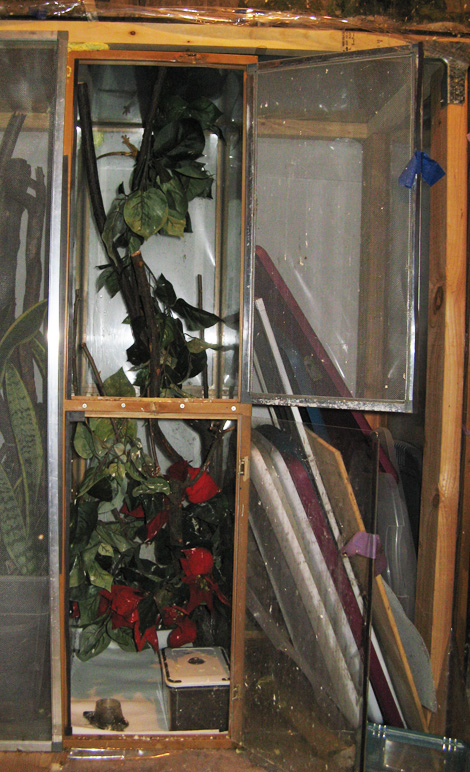Crested Gecko Care Sheet Summary
Feeding
- Give them Crested Gecko Diet. About a half a teaspoon to one teaspoon water, per animal depending on size. Follow the directions on the container. Keep the food in for two nights before changing it. Should resemble baby food in thickness, so you may need to add a bit more water.
- You may feed them calcium dusted crickets or roaches which are not wider then the space between the cresties eyes. They do not need live food but love it. I give them bugs once or twice a week
- They drink the water off the plants and walls, so make sure to spray than down well with water once a day and also provide a water dish
Conditions
- Temperature range is 65-80 degrees. Though they can tolerate temps into the high 50's and mid 80's
- Humidity should range from 50-80 % through out the day. Do this by spraying the tank down with water once a day. If the ac or heat is running, or you are in a very dry climate, you may want to spray more.
Housing

- Crested geckos get up to 9 inches long with tail and are usually about 45 grams as an adult.
- If the baby is under 5 grams, keep it in a medium Kritter Karrier or gallon size container, until it is 5 grams
- Bigger ones can be housed in their adult size cage 15 gallons for one animal, add 10 gallons per additional animal. Young ones may be kept in smaller tanks appropriate to their size
- Do not house two males together, but you may house young ones, and multiple females together. Females should not be housed with males until they are at least 35 grams.
- Only house animals of similar size together
- They are arboreal, so get a tall tank or set yours on its end.
- Give them lots of plants (fake or live) and branches to climb on. They would also like hides and cork bark. Make sure tank decore is very clean before putting it in the tank.
- They do best in mostly glass or plastic tanks with one side in screen. Make sure the screen and door are very secure or they will escape. Solid sides helps with humidity.
- Use paper towel on the bottom of the tank to start with. You may go with a very fine material such as sphagnum peat or moss, or products such as bed a beast or eco earth, which are very fine coco. I only use paper towel for my cresties.

Handling
- Handle them for short periods of time until they get used to you, but they will, in time, be more than happy to hang out with you for hours.
- Don’t grab them by their tails or they will lose them and they will never grow back.
- Handle them carefully as the small animals they are.
- They jump. Snag them as quickly as you can, though they do pause a moment before skittering off.
Lessons you don’t want to learn the hard way
- Find a good local reptile vet.
- If a gecko gets clawed or bit by a cat take it to the vet. The scratches and bites usually get infected and the gecko dies with in about 3 days. They need antibiotics as soon as possible. The sooner the better, best is with in a day. You can place honey on the wound until you get it to the vet.
- When the babies get food on their feet, or if an adult is having shed problems, or they just looks dry; place then in a small plastic container with lid, a paper towel with a millimeter of standing water that is warmish – in the low eighties. Leave them in there about 20 minutes and this should help. You may take a Q-tip, put it under the foot and roll it towards the toes to get food off the bottom of its feet. Also you may use a Q-tip to gently remove food any where on its body.
- If a crestie is injured, lost its tail or seems sickly, place it in a very clean container such as a plastic shoe box with holes, or a medium KK, lined with paper towels. Keep it really clean.
- Don ‘t feed mealworms, they come out mostly undigested in the poop and have resulted in impaction.
- If a gecko looks poorly, isolate in a really clean environment. If it is losing weight, try putting food on its nose and let it lick it off.
- Quarantine you new animals. I go for four weeks and if they are pooping and look healthy I put them with others.
- If they are pooping they are eating.
- Don’t grab the gecko by the tail.
- Use the crested gecko diet, dust you insects with calcium, do not feed baby food or fruit as anything other then a rare treat, or risk malnutrition.
- If you see a problem deal with it as soon as possible. Even if it is to get help on a forum. I highly recommend Pangeareptile.com which as been a great help to me.
I really advise you to do further research on crested geckos. This care sheet is to get you started. The forum on Pangeareptile.com is a really great resource for information and support, as well as many supplies such as crested gecko diet in larger quantities: I highly recommend it. If you have questions, feel free to contact me
